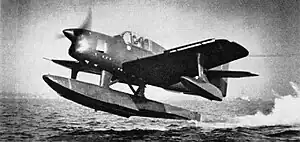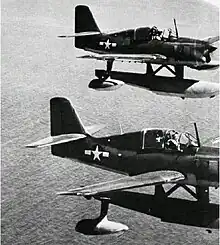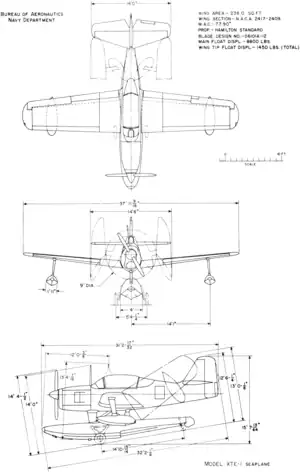| OSE | |
|---|---|
 | |
| Role | Single-seat multirole floatplane |
| Manufacturer | Edo Aircraft Corporation |
| First flight | 1946 |
| Number built | 10 |
The Edo OSE was a 1940s American single-seat multi-role floatplane designed and manufactured by the Edo Aircraft Corporation.
Design and development
The Edo Aircraft Corporation was an established company that produced seaplane floats. In 1946, Edo designed its first aircraft, the Edo OSE. Two prototype aircraft (designated XOSE-1) were built and flown in 1946. The XOSE-1 was a single-seat low-wing cantilever monoplane with a single float and fixed wingtip stabilizing floats. The wings could be folded for shipboard storage. The aircraft was designed for a variety of roles including observation and anti-submarine patrols. Unusually, it was designed to carry a rescue cell on the underwing hardpoints, which would be capable of carrying a single person when used for air-sea rescue. Eight production aircraft (designated XOSE-1) were built to a United States Navy order but none were accepted into service. A two-seat training conversion was carried out as the XTE-1, but production TE-2 aircraft were cancelled.
Variants


- XS2E-1
- Original designation for OSE and TE single seat floatplane scouts.
- XOSE-1
- Prototypes and production single-seat aircraft redesignated from XS2E-1; eight built.
- XOSE-2
- Prototype two-seat floatplane scout aircraft, two converted from XOSE-1.
- OSE-2
- Production two-seat floatplane scout aircraft, four aircraft were assigned Bureau of Aeronautics numbers (BuNos.), but production was cancelled.
- XSO2E-1
- Original designation for XTE-1 conversions.
- XTE-1
- Two-seat floatplane trainer conversions, two aircraft converted from the XOSE-1 prototypes.
- TE-2
- Developed from the TE-1, four aircraft were assigned BuNos., but production was cancelled.
Specifications (XOSE-1)

Data from Jane's all the World's Aircraft 1947,[1] Aerofiles[2]
General characteristics
- Crew: 1
- Length: 31 ft 0 in (9.45 m)
- Wingspan: 38 ft 0 in (11.57 m)
- Width: 14 ft 6 in (4.42 m) folded
- Height: 14 ft 11 in (4.55 m) wings spread; 4.16 m (13.6 ft) wings folded
- Wing area: 237 sq ft (22.0 m2)
- Airfoil: root:NACA 2417; tip: NACA 2409
- Empty weight: 3,973 lb (1,802 kg)
- Gross weight: 6,064 lb (2,751 kg)
- Powerplant: 1 × Ranger V-770-8 V-12 inverted air-cooled piston engine, 550 hp (410 kW)
- Propellers: 2-bladed Hamilton Standard D601a-12, 9 ft 0 in (2.74 m) diameter constant speed airscrew
Performance
- Maximum speed: 198 mph (319 km/h, 172 kn)
- Range: 900 mi (1,400 km, 780 nmi)
- Service ceiling: 22,300 ft (6,800 m)
Armament
- Guns: 2x fixed forward-firing wing-mounted 0.5in (12.7mm) machine-guns
- Bombs: 2x 350 lb (160 kg) bombs / depth charges / rescue pods
See also
Aircraft of comparable role, configuration, and era
Related lists
References
- ↑ Bridgman, Leonard, ed. (1947). Jane's all the World's Aircraft 1947. London: Sampson Low, Marston & Co. p. 172c.
- ↑ Eckland, K.O. "American airplanes: Ea - Ew". Aerofiles. Retrieved 7 December 2017.
- The Illustrated Encyclopedia of Aircraft (Part Work 1982-1985). Orbis Publishing.